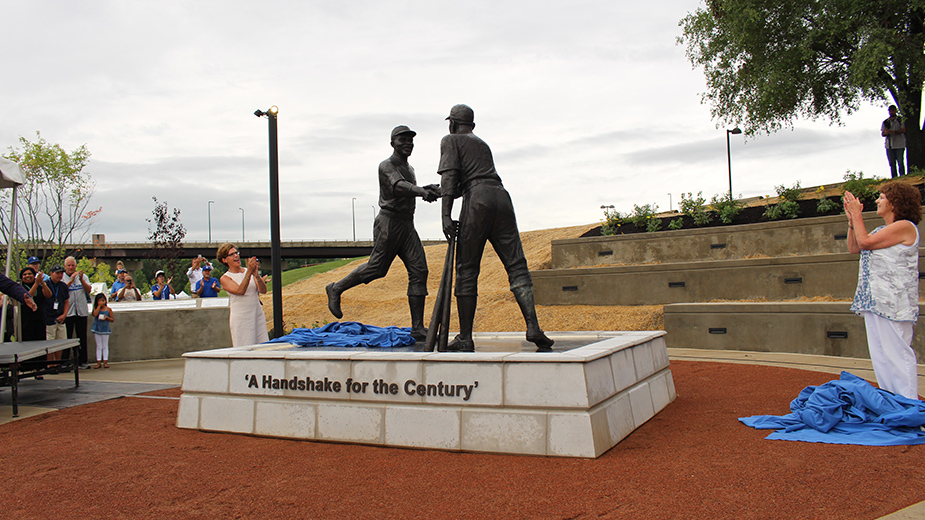Robinson-Shuba Statue Unveiled In a Victorious Ceremony
YOUNGSTOWN, Ohio – With a tugging of rope, the sheets draped over the statue of Jackie Robinson and George “Shotgun” Shuba fell away.
The dramatic moment revealed the 7-foot tall bronze work of art justifiably titled “A Handshake for the Century.” It was the culmination of at least two years of work that was – as the late Shuba himself might have said – the right thing to do.
The $400,000 statue project in Wean Park, downtown, depicts the April 18, 1946, moment when young Jackie Robinson, the first Black man to play professional baseball, crossed home plate after hitting a home run in his first at-bat.
Extending a hand in congratulations was Youngstown native Shuba, the on-deck batter and his teammate on the Montreal Royals, a minor league affiliate of the Brooklyn Dodgers. The following year, the hall of famer Robinson would break Major League Baseball’s color barrier.
The 1940s were a time of deep racial prejudice, and Shuba’s simple gesture was photographed, and became an iconic representation of racial harmony.
Like Robinson’s first hit in professional baseball, the Robinson-Shuba statue – created by Connecticut sculptor Marc Mellon – is a home run.
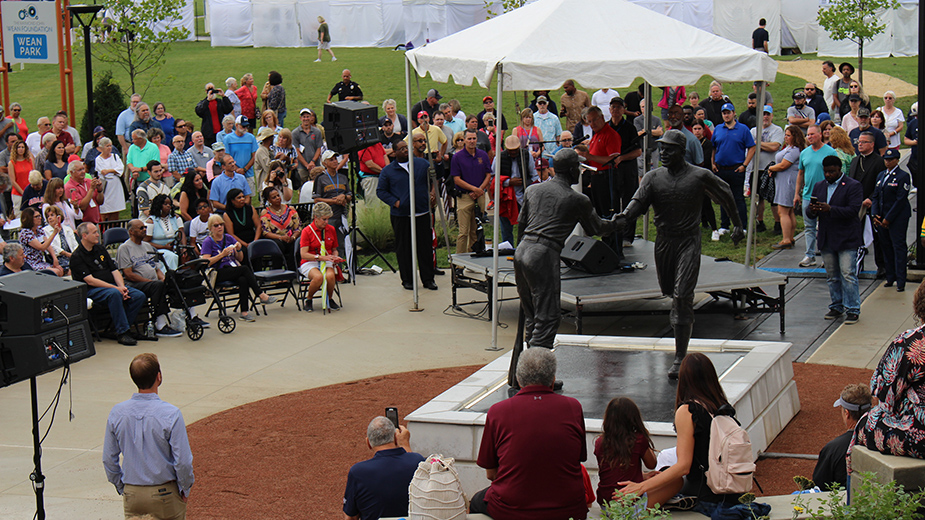
Saturday’s unveiling ceremony drew hundreds of spectators to the site. The skies remained grey but the nonstop rain halted for the hour-long event.
The statue is the eighth one erected in the United States of Jackie Robinsson, but the only one that has another person in it, said Mayor Jamael Tito Brown.
Eric Planey, a New York banker and Youngstown native, was the driving force behind the Robinson-Shuba statue. After conceiving of the idea, he and others formed a committee, led by Greg Gulas, Ernie Brown and Herb Washington, who worked to raise money and make the idea a reality.
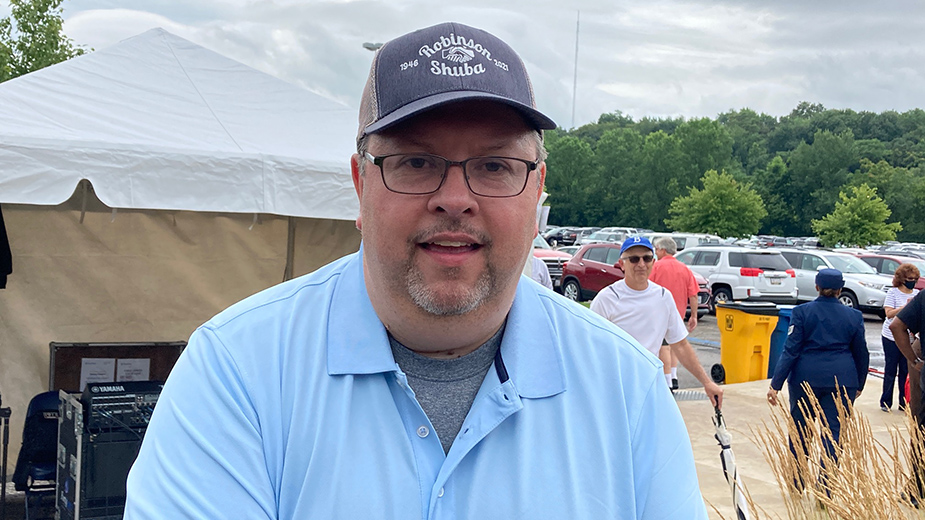
Planey credited the committee, which he has dubbed “the bullpen,” saying they brought the project home the same way that Shuba welcomed Robinson to home plate.
“Over the last several days, I [learned] a little about how Jackie may have felt,” Planey said. “I came back to Youngstown Thursday to see the extended hands of my teammates, the women and men who stood with me to bring the statue project home.”
Mike Shuba, the son of the late ballplayer and a Youngstown resident, became emotional as he addressed the crowd, fighting back tears.
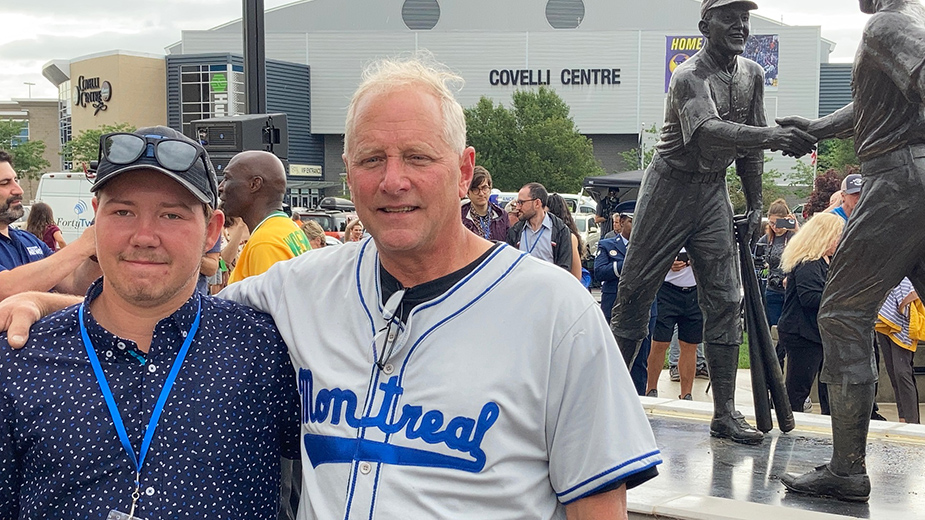
Wearing a Montreal Royals throwback baseball jersey, Shuba recounted how, as a younger man, he realized that his father’s gesture was being lost to history.
He set about to ensure that his father’s deed was remembered; the two of them began traveling the country for speaking engagements with youngsters.
Shuba said his father’s advice was to do the right thing in a big situation and everything will turn out fine. But the sharp-hitting ballplayer never sought the spotlight for his efforts.
“My dad was reluctant [to talk about the handshake] and he said, ‘that’s not my moment, it’s Jack’s. And anyway, that was 50 years ago and not many people even remember it or care,’” Shuba related. “I said, I care and maybe I’ll live long enough to see a statue of that moment in my hometown. Today that dream comes true for me.”
Shuba said that the only bit of memorabilia of his baseball career that his father ever displayed in their Youngstown home was the handshake photo.
Councilman Julius Oliver, who was part of the statue effort, said victory comes through teamwork.
“I believe that George Shuba recognized Jackie Robinson as a Black man,” he said. “But also as a teammate and somebody that they needed to win. I want us to consider that as Youngstowners and as members of the human race, we are all members of the same team, and we all need each other to win this game of life.”
Ernie Brown, one of the statue committee chairs, pointed to the significance of the handshake and how the Robinson-Shuba statue can serve as a teaching place for years to come.
“Hopefully, the significance of the handshake will resonate for generations,” he said.
Louis Zona, executive director of the Butler Institute of American Art, recommended sculptor Marc Mellon for the job. As the art expert gazed at the newest piece of public art in the city, he said, “It’s wonderful, and so is the fact that it celebrates two great men and two great athletes and that it’s all about Youngstown.”
The unveiling, which capped the ceremony, was done by Jan Strasfeld, former director of the Youngstown Foundation, and Sally Bany, chairwoman of the Lamfrom Charitable Foundation of Oregon, who pulled the ropes that unsheathed the sculpture.
Both organizations were major donors to the project.
Mayor Jamael Tito Brown gave the countdown. But shortly before, he acknowledged Bany and gave her a key to the city and an official proclamation.
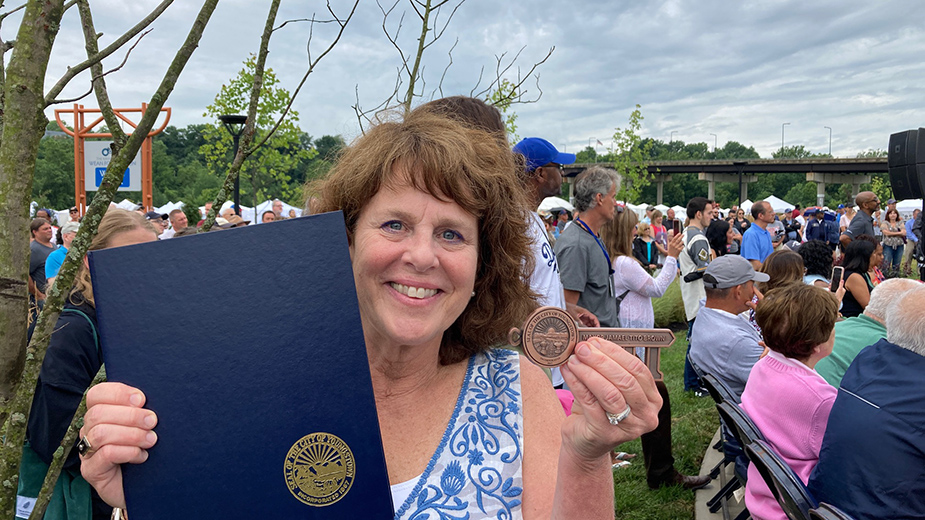
Bany said she felt a kinship to the city because her father, who died in the 1970s, is from Youngstown.
Bany is an Oregonian who had never before visited Youngstown. She recalled how she was moved to get involved after she saw a segment on the project on a Sunday morning television show.
The next morning, she told her daughter to call Eric Planey to see what he needs to finish the project. Her foundation gave the final $175,000 that was needed to put the fundraising over the top.
“You have to keep teaching generations to be kind to each other no matter what race you are,” Bany said. “Let’s be kind to each other. That split-second when George Shuba came forward, that’s how everybody needs to be.”
Pictured at top: Jan Strasfeld and Sally Bany did the honors, unveiling the statue. Strasfeld is the retired director of the Youngstown Foundation; Bany’s father grew up in Youngstown. The Youngstown Foundation and Bany’s Lamfrom Charitable Foundation of Oregon provided the largest donations to make the $400,000 become reality.
RELATED:
Robinson-Shuba Statue Guided by Fate, Project Creator Says
Copyright 2024 The Business Journal, Youngstown, Ohio.
